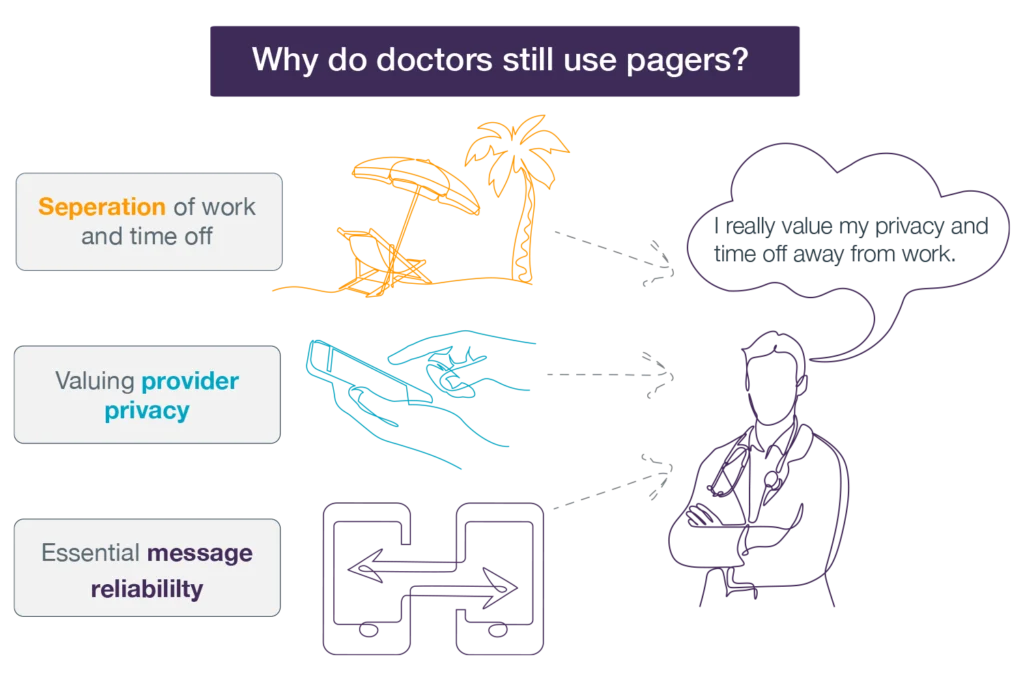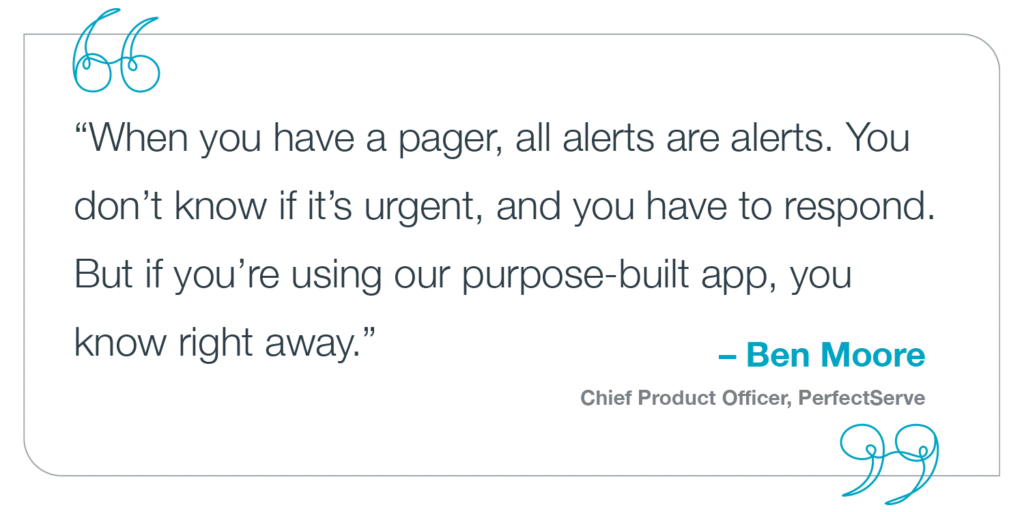Physical Address
Jen A. Miller is author of Running: A Love Story. Her work has appeared in The New York Times, Washington Post, CIO Dive, Supply Chain Dive. and Runner’s World. She lives in N.J. with her dog Annie Oakley.
Why the Hospital Pager Withstood the Test of Time
Jen A. Miller is author of Running: A Love Story. Her work has appeared in The New York Times, Washington Post, CIO Dive, Supply Chain Dive. and Runner’s World. She lives in N.J. with her dog Annie Oakley.
Pagers, at one time both a symbol of status and an annoying distraction, have become passé. In a world with smartphones, virtually no one needs a device with limited communication functionality — except in healthcare.
Nearly 80 percent of hospitals still use pagers, according to a recent study in the Journal of Hospital Medicine. Maybe that’s apt, as pagers first found their footing in hospitals, beginning in New York City in 1950, when they cost about $120 per month in today’s dollars. Healthcare organizations needed to make doctors more reachable for their patients, and they still do.
Even as consumers shifted away from pagers to two-way texting devices, then to cellphones, then to smartphones, pagers have persisted in hospitals.
What Is a Hospital Pager?
The first one-way radio communication system was deployed by the Detroit Police Department in 1928. The first telephone pager was patented in 1949 by Al Gross, and used in New York’s Jewish Hospital in 1950.
The devices were described as part of a “radio paging service,” according to a 1951 issue of Popular Science. “A supplement to the telephone-answering services many doctors use, it can tell a physician anywhere in the city that an important message is awaiting him,” according to C. Ennis, writing for Popular Science.
A pager then looked like a remote control with an antenna. It weighed six ounces, had a 25-mile range and a battery that lasted six months.
Motorola came up with the name “pager” in 1959, and ran away with pager technology by introducing the first tone-only pager in 1964, called the Pageboy. Doctors would hear the tone (or beep, hence the nickname “beeper”) and call the hospital operator for a message.
Tone and voice pagers came along in the 1970s and could not only alert a doctor that he or she was needed, but also explain why. Alphanumeric displays followed in the 1980s. Worldwide use climbed from 3.2 million pagers in 1980 to 61 million in 1994.
Why Do Hospitals Still Use Pagers?
In the Journal of Hospital Medicine study, 49 percent of respondents said they receive patient care–related messages most commonly by pager. A study in the journal BMJ Quality and Safety also found that paging rate and volume have not decreased in 25 years despite the introduction and use of new technology.
Pagers continue to live in hospitals in part because they work where cellphones won’t. Hospitals have cellular and Wi-Fi dead zones, particularly in spots where walls have been built to stop X-ray exposure. Pagers get the same kind of range as an FM radio station, and signals go to multiple satellites instead of just one, as cellphones do.
“This redundancy increases the reliability of the message getting through, because if one tower is down, the others are usually working,” Dr. Shoshana Ungerleider, internist at Sutter Health’s California Pacific Medical Center, tells MSN. She also adds that pagers have a long battery life, which means they need to be charged only every week or two, compared with smartphones, which must be charged at least daily.
Pagers also work when cellular networks are down or turned off, as happened during the 2013 Boston Marathon bombing.
There’s a patient security angle too: Encrypted pagers are seen as being less hackable than smartphones, while also being HIPAA-compliant. “They send only numeric messages or basic text messages,” pediatrician Dr. Jarret Patton, founder of the coaching and consulting firm Doctor Jarret, tells MSN. “This way, no confidential information can get in the wrong hands, as could happen with a cellphone.”
Fast, Cheap, and Deeply Entwined in Legacy Systems
This doesn’t mean doctors love them. “I still remember the excitement and anticipation of receiving my first pager as a medical student. It meant the years spent hunched over a textbook were over; I was entering the fray of patient care,” Dr. Allison Bond writes in Slate. “That feeling quickly turned to irritation as I became painfully aware of pagers’ shortcomings,” which include their “rude, sudden blare, with a knack for jolting me awake on call just as I drift into a shallow, anxiety-ridden sleep.”
But pagers are still in use because they’re low maintenance, rarely need to be charged (and thus continue working during power outages) and can send group messages almost instantaneously (enabling healthcare providers to quickly notify a medical team of an emergency).
Other technologies that offer more flexibility and valuable capabilities may ultimately replace pagers on the medical landscape, but for now, pagers are still a part of the scene.
Do Doctors Still Use Pagers?

In today’s fast-paced healthcare environment, technology plays a crucial role in improving communication and streamlining processes. However, it may come as a surprise to learn that pagers are still prevalent in many hospitals, clinics, and medical facilities.
Why Do Hospitals and Clinics Still Use Pagers?
In an interview, PerfectServe Chief Product Officer Ben Moore detailed why pager use persists among doctors. Let’s explore why it’s time for healthcare organizations to embrace modern solutions and bid farewell to antiquated pagers.
The Reliability Factor
According to Moore, there are nearly 800,000 pager devices still in circulation today, and their primary users are doctors. Many doctors cite the pager’s reliability and connectivity as one of the reasons they continue to use technology that most consider to be outdated. Even in areas with poor cell reception, doctors can trust that messages will always find their way to them, ensuring uninterrupted connectivity and greater peace of mind.
PerfectServe recognizes the need to address these concerns using cutting-edge software. By introducing virtual pager functionality, PerfectServe allows doctors to transform their smartphones into powerful communication tools while retaining the reliability they value in traditional pagers.
Separating Work and Personal Life
Maintaining a healthy work-life balance is crucial for doctors and is another key reason why doctors hold onto pagers: They want clear separation between work and their personal lives. With a virtual pager number provided by PerfectServe’s app, doctors can enjoy the benefits of a separate contact number while also using their own mobile device. This allows them to call patients or other clinicians while hiding their personal number and it provides the option to maintain privacy by displaying the hospital or clinic’s caller ID. Additionally, call schedules are seamlessly managed, automatically transitioning doctors off-call when they’re not required to receive messages.

Combining Pagers with Modern Technology
Enhancing Reliability and Escalation
PerfectServe’s software-based approach further enhances reliability. In the event a message fails to reach its intended recipient, the software can automatically escalate the communication. This may involve a message to the attending physician, who is able to customize how they receive work-related alerts on their own mobile device. A backup physician can be notified as well, ensuring critical messages are promptly received. By leveraging these technological advancements, PerfectServe makes the paging service ultra-reliable, eliminating the risk of missed or delayed notifications.
Eliminating Alert Fatigue
Pagers have a notorious side effect—alert fatigue. Every message, regardless of urgency, sounds the same and demands the doctor’s attention. PerfectServe’s purpose-built app tackles this issue head-on. Low-priority messages are subtly indicated, maybe with a vibration in the pocket, while critical alerts related to acute patient care are more assertive, ensuring doctors prioritize urgent matters promptly. The app provides more context and information, going beyond the 140 character limit of a pager message. Integration with health records offers doctors access to patient details, saving valuable time spent searching for information.

Harnessing Smart Technology
PerfectServe’s commitment to improving physician workflows extends to collaborating with Apple and Google. Through special permissions, PerfectServe notifications can be set to override silent mode, the hardware setting that mutes smartphone notifications. This ensures that time-sensitive messages intended for on-call doctors are able to break through the silence. By doing so, it eliminates unnecessary disruptions while guaranteeing that doctors never miss crucial communications, striking a balance between uninterrupted workflow and immediate responsiveness. Doctors can focus on their work without constantly being interrupted by routine notifications, ensuring that they receive critical messages when necessary.
As the healthcare industry evolves, it’s imperative for doctors, nurses, and entire care teams to embrace innovative solutions that improve efficiency, enhance patient care, and alleviate the burden on healthcare professionals. PerfectServe’s virtual pager system presents a clear advantage over traditional pagers, offering reliability, separation of work and personal life, improved escalation protocols, and a smarter approach to alert management.
It’s time for healthcare organizations to leave pagers behind and embrace the much richer possibilities afforded by modern technology.
Are you ready to see how PerfectServe can work for your organization? Schedule a demo with us today.









